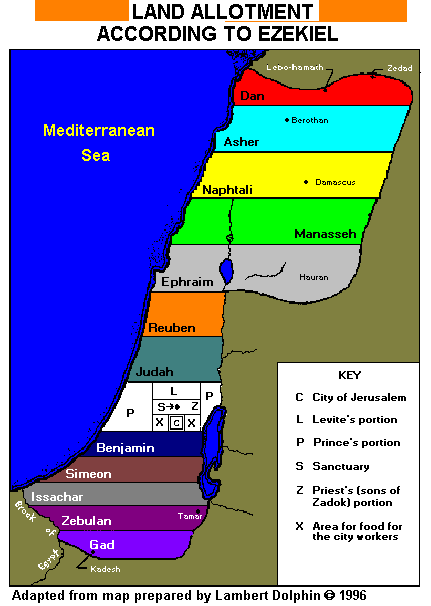So many Christians like to speculate on the rebuilding of the Temple in Jerusalem.
So do lots of Jewish people.
Where in the bible does it say that it has to be built in Jerusalem?
The last two were there, yes. But where does it say unequivocally the third will be built? Or the fourth?
Response: To religious Jewish people today, the next Temple that will be built will be the Third Temple and this Third Temple will be governed by "The Prince" or "Messiah." Christians have a different interpretation based on New Testament. Christians believe that the Third Temple will see a False Messianic figure. They also believe that Ezekiel's Temple will be the Fourth Temple that Messiah the Prince will inhabit.
In other words, both groups of people see Ezekiel's Temple as being the place of Messiah.
If religious Jewish people are right that they are going to building Ezekiel's Temple in the near future, then Ezekiel talks about the location of this Third Temple.
If you take Ezekiel's description literally, then according to Ezekiel, Jerusalem would be about 40 miles in circumference and thus ten times the circumference of the ancient city. Furthermore, the Temple area would be about ten miles north of that of ancient Jerusalem's center, in Samaria. A simple reading of a map would put that location at Bet-El (Bethel), where Jacob had the vision of a ladder reaching into heaven.
With regard to the problem of the Temple being located about ten miles north of Jerusalem, God specifically indicates to Ezekiel that the Temple area will no longer adjoin the royal palace as in the days of old (43:7-9). This is a reference to the ancient City of David. The point is clearly stated in 43:12 -- "This is the law of the house: upon the top of the mountain the whole limit thereof round about shall be most holy. Behold, this is the law of the house." At least in the Book of Ezekiel, there are described vast topographical changes will not make Israel less the Promised Land for Israel, nor will a centralized, enlarged Temple ten miles removed from the city be a disappointment to Israelis who have been accustomed to thinking of it in terms of Mount Moriah.
A close reading of Ezekiel also describes the reapportionment of the land in specific lots during the his Temple's period. The Temple and the Temple district are not part of the rebuilt city of Jerusalem according to the details of this reapportionment. Note again, that the Temple area will be located to the North of rebuilt Jerusalem:
"When you allot the land as a possession, you shall set apart for the Lord a portion of the land as a holy district, twenty-five thousand cubits long (7.1 Miles), and twenty thousand cubits (5.8 Miles), broad; it shall be holy throughout its whole extent. Of this a square plot of five hundred by five hundred cubits (0.142045 Miles) shall be for the sanctuary, with fifty cubits (0.0142045 Mile) for an open space around it. And in the holy district you shall measure off a section twenty-five thousand cubits long (7.1 Miles) and ten thousand (2.84 Miles) broad, in which shall be the sanctuary, the most holy place. It shall be the holy portion of the land; it shall be for the priests, who minister in the sanctuary and approach the Lord to minister to him; and it shall be a place for their houses and a holy place for the sanctuary. Another section, twenty-five thousand cubits long (7.1 Miles) and ten thousand cubits broad (2.84 Miles), shall be for the Levites who minister at the temple, as their possession for cities to live in."
"Alongside the portion set apart as the holy district you shall assign for the possession of the city an area five thousand cubits broad (1.42 Miles), and twenty-five thousand cubits (7.1 Miles) long it shall belong to the whole house of Israel."
"And to the prince shall belong the land on both sides of the holy district and the property of the city, on the west and on the east, corresponding in length to one of the tribal portions, and extending from the western to the eastern boundary of the land. It is to be his property in Israel. And my princes shall no more oppress my people; but they shall let the house of Israel have the land according to their tribes." (Ezekiel 45:1-8.)
"Adjoining the territory of Judah, from the east side to the west, shall be the portion which you shall set apart, twenty-five thousand cubits in breadth (7.1 Miles), and in length equal to one of the tribal portions, from the east side to the west, with the sanctuary in the midst of it. The portion which you shall set apart for the Lord shall be twenty-five thousand cubits in length (7.1 Miles), and twenty thousand in breadth (5.8 Miles)." (Ezekiel 48)
It is quite obvious from the text of Ezekiel, that there isn't room in the City of Jerusalem of such a "Holy District" to exist expanding from the center of the current theorized site of the next Temple.
The prophet Ezekiel (Ezekiel 40-48) describes in great detail a temple in Israel that is much too large to fit on the present Temple Mount site. The Temple of Ezekiel proper measures about 875 feet square, and it sits in the middle of a large consecrated area.
So...if today's Orthodox Jewish movement to rebuild the Temple is seriously focused on building Ezekiel's Temple, then--it will not be built in Jerusalem, but in today's Samaria.






